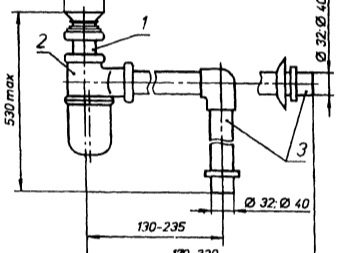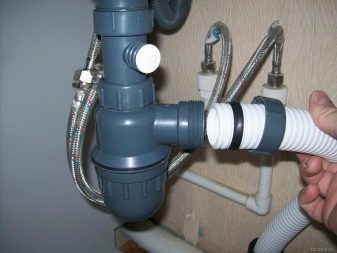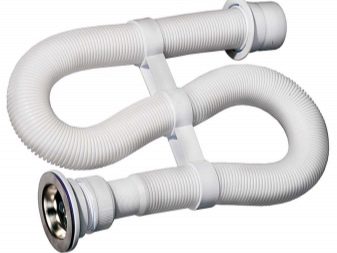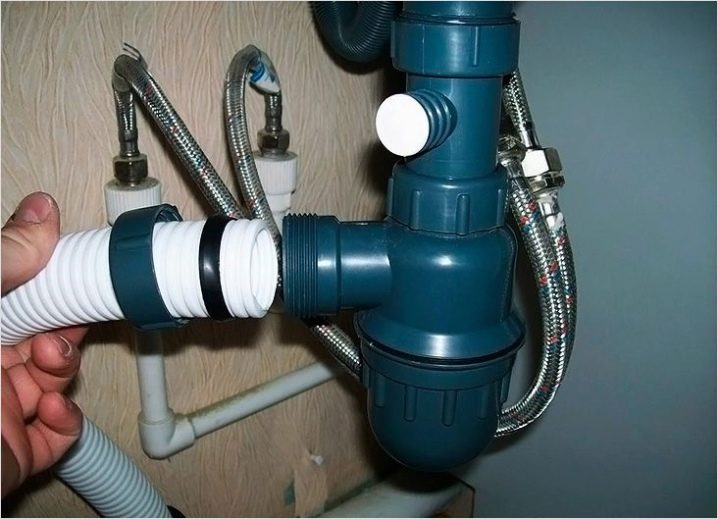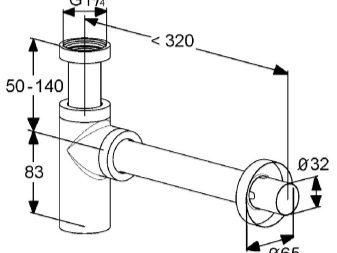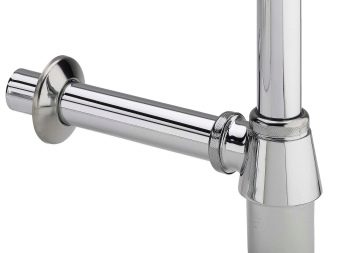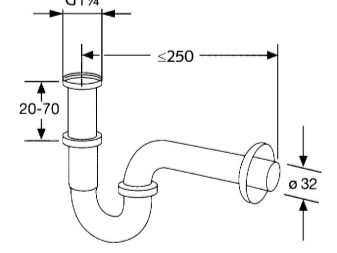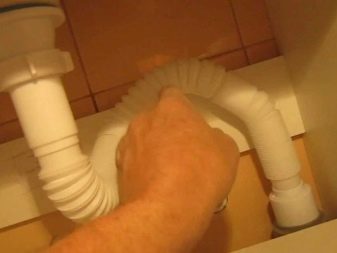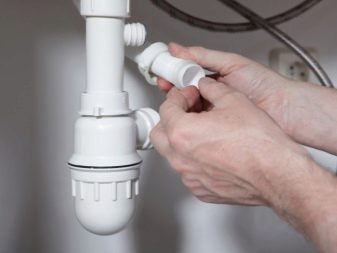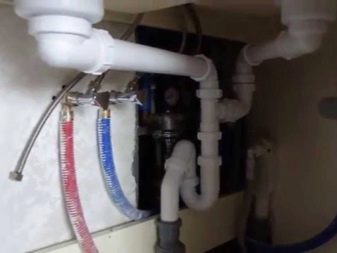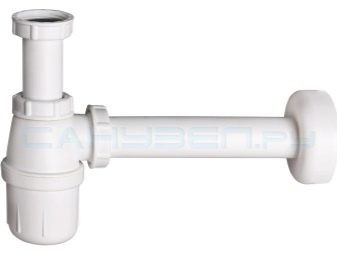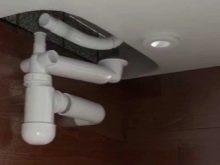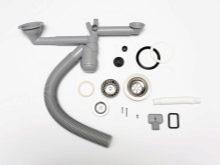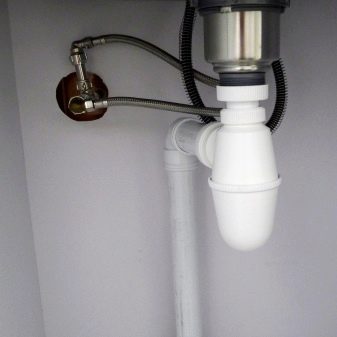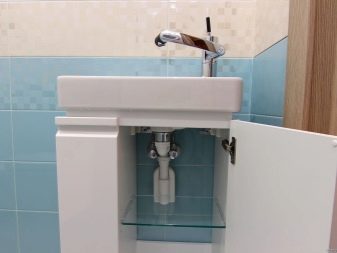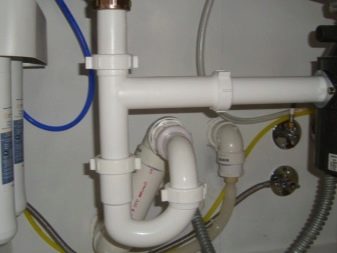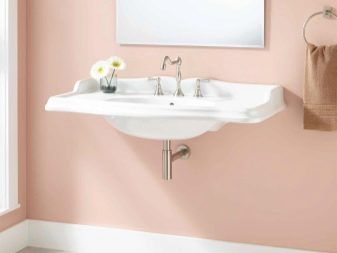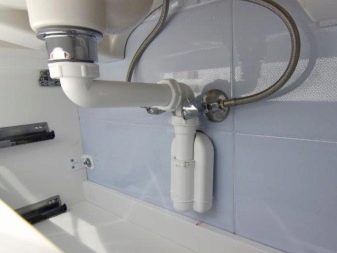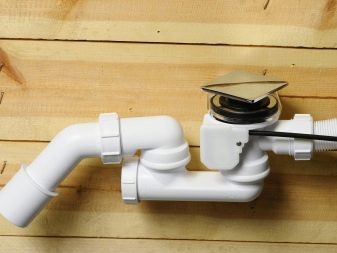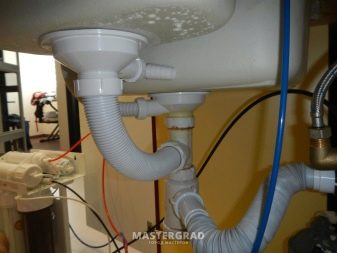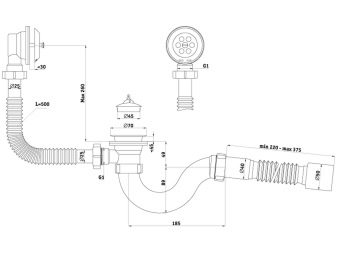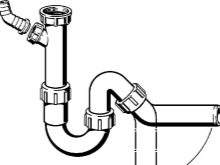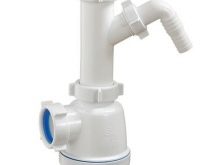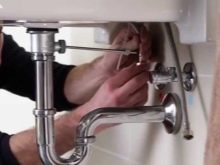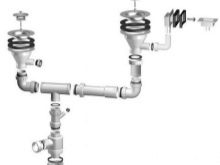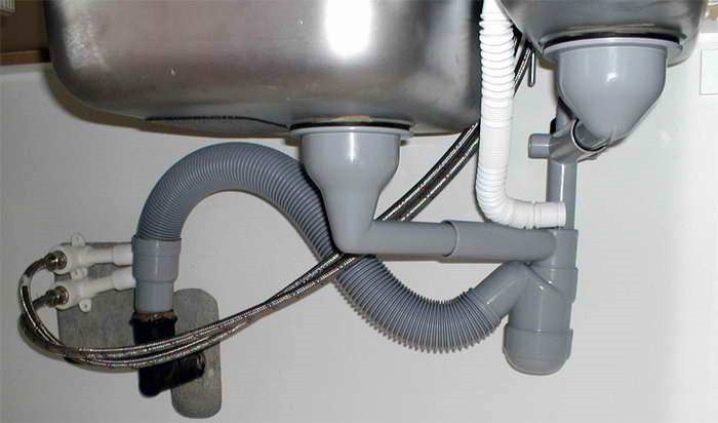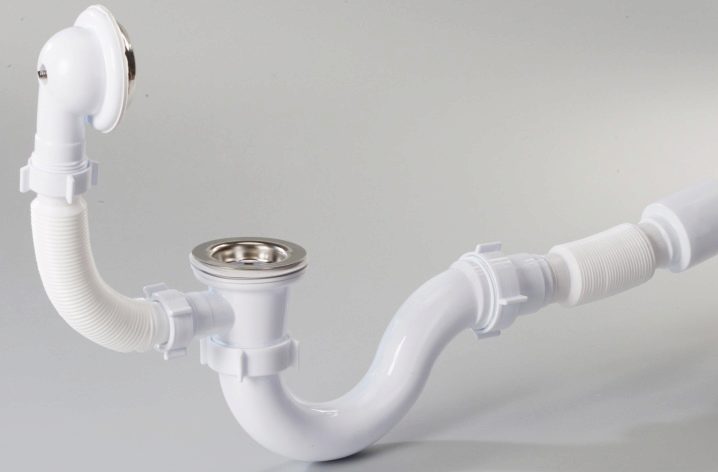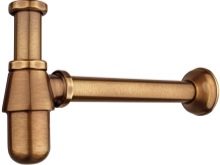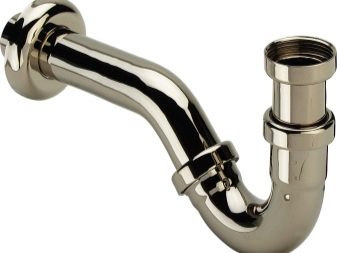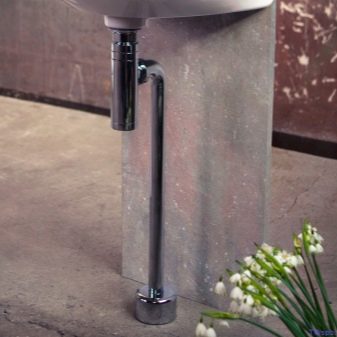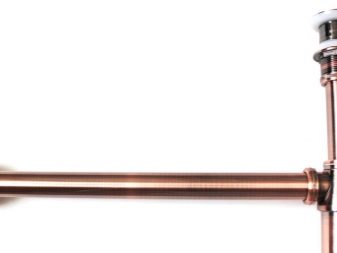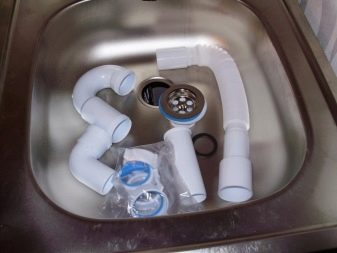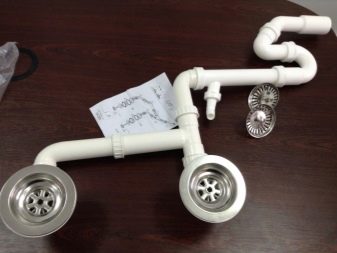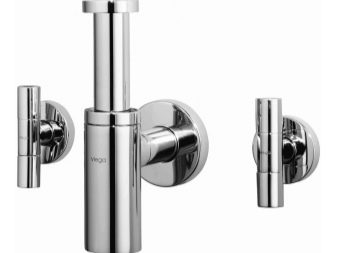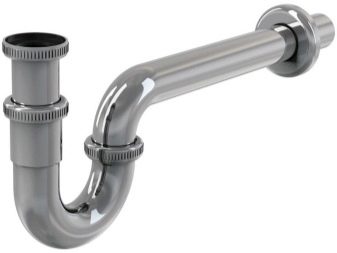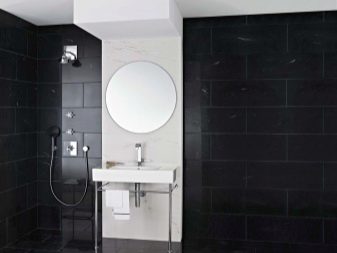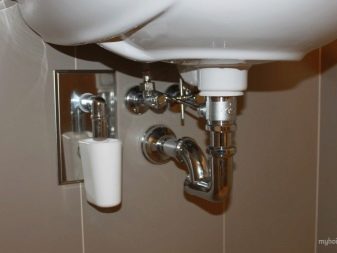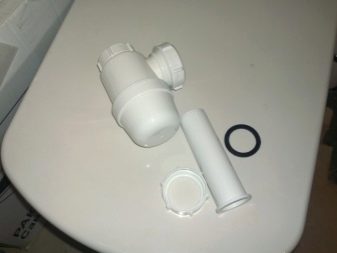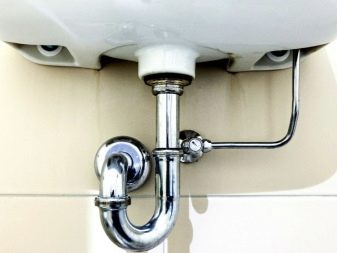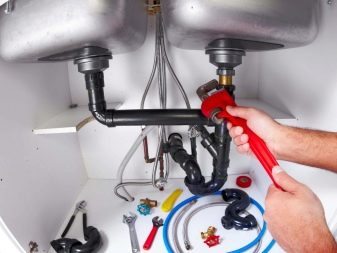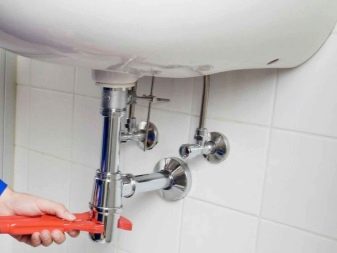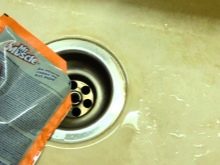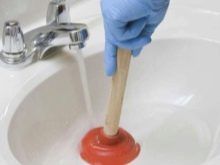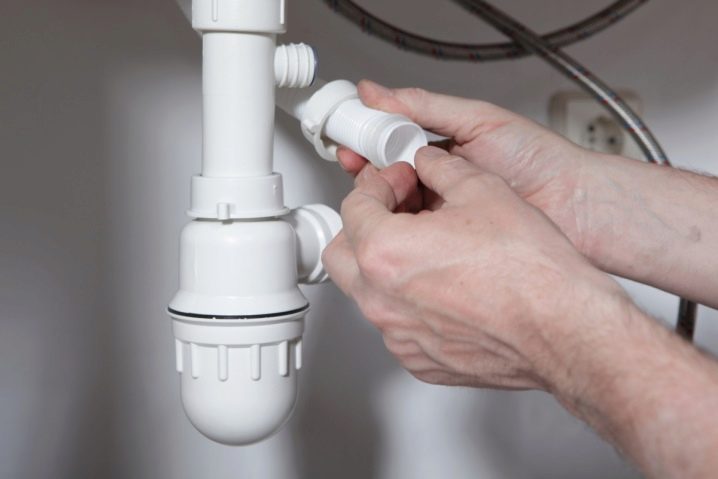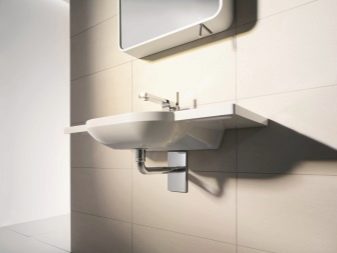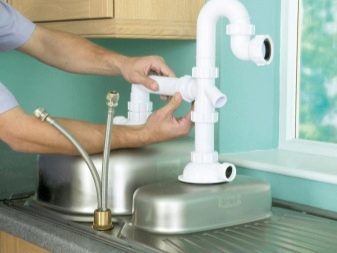Siphons for a sink: versions, sizes and forms
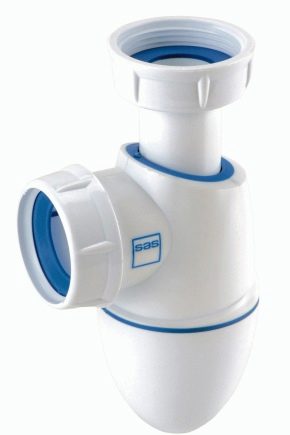
Siphon for sinks is one of the main components of drainage. Currently, plumbing stores have a wide range of siphons, but in order to choose the right one, you need to know some of their features.
How does it work and what is it for?
Siphon - in the literal sense, it is a pipe that is needed in economic life in order to ensure the unobstructed discharge of sewage, but thereby preventing the smell of sewage from entering the atmosphere of the kitchen or bathrooms. The principle of operation of the siphon is ensured due to its special structure in the form of a curved tube, due to this curvature a water plug or a so-called hydrolock is formed,which provides a mechanism for sealing the room from sewage, preventing ingress of odors, but freely provides the flow of fluids into the sewage system.
Knowing the structure of the siphon is necessary not only to understand its work., but also for its further self-replacement, because besides natural wear and tear, there may be emergencies when it will be necessary to react quickly, and there will not be time to wait for any other specialized help. In principle, one tube bent under 1800 is sufficient to create a barrier between the sewer pipe and the room; such a model was used earlier, before the discovery of new technologies and the emergence of design ideas in the sanitary design industry.
The generalized structure of the siphon is considered below, of course, depending on the different models there are some peculiarities.
- Removable (protective) mesh - designed for the primary filtering of garbage, while large parts remain and do not fall into the pipe, preventing clogging. It is located above the node attached to the sink. If the sink does not provide for a protective wall, you should think about buying a washbasin with a colander that will cope well with this function.
- The overflow pipe or outlet is a different system to prevent the overflow of the wash / bath with water, which is attached to the drain pipe, protecting it from flooding.
- Rubber gaskets having a thickness of from 3 to 5 mm in black or white color, due to which tight connection of the siphon parts is provided.
- Branch pipe - located under the sink / washbasin.
- Connecting screw - for fastening all the details.
- Actually, siphon.
- Sewer drainage.
Kinds
The construction market provides many varieties of siphons, differing in material, shape, size. All siphons can be divided into two large groups - they are wet and dry, each of these groups consists of mini-subgroups.
Depending on the design
The most common are the following options.
Bottle - its main function is performed due to the water content in its flask, which prevents the flow of sewage gases into the room. This is one of the most common options that is found in almost every apartment. Bottle siphons can be of various shapes and square, rectangular, round.
Pros:
- it can be both with one and with two taps, which provides connections to it not only with sinks / sinks, but also with other devices (washing machine, dishwasher);
- universal in its application, suitable for closed shells with a pedestal of the "tulip" type;
- in case of accidental ingestion of jewels and other things into such a siphon, you can quickly find them, because they settle at the bottom of the flask, and when disassembling, you can easily get them;
- the accumulated dirt on the walls of the siphon is well cleaned by special means.
Minus one - the siphon is quite voluminous, thus will take up space under the sink.
Tubular - a simple siphon, which is represented by a conventional curved tube more often S-shaped or U-shaped, resembling a corrugated siphon, but instead of a corrugation there is a straight, smooth pipe.
Pros:
- easy to use, if necessary, the curved part can be dismantled and remove contamination;
- direct-flow type of structure well protects from blockages;
- it is possible to use in a suspended form with open sinks.
Minuses:
- a water blockage is formed in a small depression, if it is rarely used, then evaporation of water with the release of an unpleasant odor is possible;
- for cleaning it is necessary to completely dismantle.
Corrugated - the simplest type, presented in the form of sanitary flexible corrugated tube. One of its ends is attached to the sink, and the corrugation is directly connected to the sewer pipe, in the middle with the help of a clamp a necessary bend is formed, in which water is constantly located (water lock), thus preventing the unpleasant smell from leaving.
Pros:
- simplicity in construction provides easy installation in the future;
- does not require a large space under the sink;
- due to its flexibility, it is possible to position the pipe in a convenient way, to lengthen or shorten it.
Minuses:
- often under the influence of high temperatures (boiling water) the corrugation is deformed;
- Gofrosiphon has a minus in the form of accumulation in its folds of fat, dirt, which will contribute to the formation of blockages, and there will be a need to change or dismantle with cleaning parts.
Dry - begins to gain momentum in sales, the special feature of the dry type trap is the presence of a rubber tube inside, which when used passes water into the sewer. After finished washing, the tube is lowered and does not let the smell, while forming the air valve.
Pros:
- since there is no water left in it, such a siphon is good for use in unheated rooms, without fear that it will burst;
- due to its structure, installation in hard-to-reach places both in a vertical position and horizontally is possible;
- does not harbor water, thereby preventing the reproduction of pathogenic microorganisms.
Minuses: often available in only two sizes.
Double siphon - this type of siphon is preferred if a house is equipped with a double sink, which often helps to save water, which is very important if there is a meter. As with other species, the double siphon has a sump into which foreign bodies can get and from where you can easily get them.
Siphon type "click-click" - refers to the automatic typein which the lid is fixed directly to the device, and by simply pressing it, it closes the hole in the drain and water is added (more often it is used in baths), when overflowed to prevent flooding, the lid itself rises and a gap forms through which water flows out.
The difference between the automaton siphon and the semi-automatic machine is that for the latter it is necessary for the person to press the button to open the hole and drain the water.
The telescopic siphon is an ideal compact invention consisting of different diameters of pipes, they are often provided assembled, that is, anyone with no skills in plumbing works will cope with the installation. In addition to its simple design, the siphon can be adjusted in depth and height, to make both a shortened and an extended version, this means that half of the space under the sink or sink will not be occupied by a siphon with the inability to hide necessary accessories there, and you can confidently put if desired, shelves, sliding lockers and more.
The wall siphon is an ideal solution for combining an aesthetic look and saving space, it fits close to the side wall. Most often used when installing the washing machine under the sink, while there remains a narrow gap between the washing machine and the wall.
Angle siphon - used in the shower, often made of stainless steel.
In relation to open areas
Depending on the location in the room siphons are divided into three types.
- Hidden siphons - reminds a bottle siphon, while the flask itself is hidden in the wall.The most costly type and inconvenient to use, but saves space under the sink.
- Open siphons - easy installation, simple and convenient maintenance.
- Flat siphon - the main reason for the application is the need to save space where there is not enough space for a standard drain design. Most often, the scope of its application are open models of lily sinks, showers, and bathrooms. This model resembles a bowl with a wide base, occupying the minimum height between the sink and the underlying structure in the form of a washing machine, shelves and other.
Pros:
- does not take up much space under the sink, due to the remaining space you can install a washing machine, cabinet;
- it is possible to install a siphon in any hard-to-reach place;
- well protects from an unpleasant sewer smell;
- water flows easily, pollution on the walls of the siphon practically does not remain due to its smooth wall structure.
With overflow
Overflow is an additional feature for the siphon that is needed to prevent flooding. It prevents overflow of sinks / bathtubs / sinks, preventing from flooding.Through an extra hole, excess water begins to flow into the drain. Depending on its connection with the siphon, the overflow can be either internal or with an integrated bottom valve, for which there is no need for an additional hole in the sink. Often, if the inner person himself does not see it, then there is no additional hole on the sink, but due to a special mechanism, it works at the required moment.
Food waste disposer
Excellent adaptation for the solution of a question with garbage bins and the littered sewerage. This device will eliminate the unpleasant smell in the kitchen.
With tap
A siphon can be with water drainage - this is the name of the part through which the drainage itself is carried out. It can be either single or double. In the second variant, there is an additional structure on the bowl itself, to which it is possible to connect other equipment where it is necessary to drain.
With valve
Such a siphon detail as a valve may be:
- ground;
- reverse;
- by air.
The air valve for sewers often needs to be installed when several devices are connected, and there is a possibility that the water lock is broken and the smell of sewage gets into the rooms.Their purpose is to normalize air pressure drops in pipes. In contrast to an air check valve, it simply lets water through in one direction, preventing it from going backwards, while it does not affect the pressure inside the pipes.
Homemade siphon
As an option, a self-made siphon can be used in suburban areas where you do not stay long and do not need his long service. Although you can not waste time on it, and just buy a washstand.
Specifications
Siphon production comes from a variety of materials, in addition to differences in this, they are diverse in shape and size.
Materials and colors
Materials for manufacturing differ in a variety. Often, siphons are hidden from a person’s eyes behind a pedestal or wall, but there are times when this can not be done, and it is worthwhile to come up with options that do not have to buy additional detail in the interior.
- Brass - products made of brass with a chrome-plated coating are often used for glass sinks, where it is necessary to preserve the general design idea. This model is perfectly combined with other similar metallic interior details.However, they require special care to preserve their appearance.
Of course, the price is much higher compared to plastic siphons, but as a result, the quality and appearance will justify the costs. Due to the mobility of parts, it is possible to choose the height of the drain, which makes such a siphon more versatile.
- From non-ferrous metals - mainly on the market there are bronze, nickel and copper siphons. Caring for them is a very painstaking job that takes time and special tools. Most often they are used to preserve the overall style of the interior. Copper is the most expensive material for the manufacture of siphons, but in terms of service life is not inferior to stainless steel.
- Steel - the main advantage is the strength of the material, over time the siphons do not leak. Basically, they are all coated with chrome, which ensures the durability of the structure. The disadvantage when chrome-plating steel is the cost of the siphon, but the quality is ensured if the coating was made correctly. To install this model, you need accurate measurements, and installation work by a plumber. Chrome-plated siphons blend perfectly with glossy faucets, towel holders and other details in the bathroom.
- Cast iron - preference is given to such a siphon when installing floor-toilets.
- Plastic - the most common type of siphon, made of polypropylene, due to which the low price of the product, but not the quality itself. The main advantages of such a siphon, in addition to low cost, are simplicity and ease of assembly, the material's resistance to chemical agents, ease of maintenance, and with dirt it can be cleaned with special means. It must be remembered that it is possible damage under the action of a thermal factor (boiling water).
Due to its properties, plastic and plastic siphons occupy one of the first places in sales.
- Bronze - looks very rich, but in the absence of proper care spoils its appearance.
The choice of colors is very large, from more common, such as white or black, to your desires. Often colors such as gold, bronze or metallic combine very well with style.
Forms
The shape of the siphon needs to be selected, if an open shell type is used, to preserve the aesthetic appearance. In such cases, more often it is S- or U-shaped, flat, square.In other cases, when the siphon is hidden from the eyes, it is worth thinking more about the quality than the form.
Dimensions
Here it is necessary to proceed from the area that you have under the sink. If you are not sure which ones to take, short or long, there are such species where you can adjust the siphon itself: both to lengthen and shorten it.
Manufacturers
The choice of siphon should consist not only of cost, it is also necessary to pay attention to the manufacturer. It often happens that products of well-known companies do not correspond to the expected and vice versa.
Below are a few options that will help with the selection.
- Viega - the slogan of this company “Quality is most important. Without quality, everything loses its meaning. ” And this is so, their main plus is the high German quality. The products have been on the market for more than 115 years, and since then much has changed, but the main thing always remains with them. Today Viega is the world market leader in the field of sanitary equipment, with more than 10 representatives in different countries of the world. One of the main branches of the work is the manufacture of mounted plumbing, which corresponds not only to the latest technical characteristics, but also has a great design. In the manufacture of their products using different materials in the form of stainless steel, copper, bronze, plastic.
- Alcaplast - The company is based in the Czech Republic, its rating is quite high on the market in Central and Eastern Europe. The main range, in addition to the creation of intake and drain mechanisms, are hidden installation systems, different types of siphons for baths, sinks, sinks, shower trays, which will help to create comfort in the house.
- Hansgrohe - a leader in design. The founder of the company is a single family from Germany, which manufactures products with a high quality standard under two brands: Hansgrohe and AXOR. The perfection of forms and functionality is good, and this is the main merit of the company. One of the few who advocate for the protection of the environment, thereby releasing a rather ecological products.
- Mcalpine –The company is from Scotland, one of the first began to produce products for water disposal of metal, then began to master the production of plastic. Today, the factory occupies a leading place in the manufacture of structures for water disposal, which include: siphons, drains, overflows, sewer pipes and more. Possessing its own laboratory, it allows the factory to check its products for quality (tightness, withstanding different temperatures and aggressive factors, etc.).
- Akvater –The company was founded in Russia in 2008. It took up the production of siphons since 2011. In a short period of time it occupies a good place on the sales market.
- Grohe - the product of German quality, due to large exports, occupies one of the leading places in the world market, without losing it in its quality. By purchasing this product, you can be confident in the functionality, originality of forms and reliability.
How to choose?
The choice of siphon should be approached very carefully. It is necessary, if possible, to find an excellent ratio of quality and cost. The most frequent questions: how to choose the right drainage system, arise when buying siphons for the sink, washbasin and bath. If an open sink is installed according to the type of glass, stone, laid ceramic shell on the tabletop or from artificial acrylic stone (which has a small water absorption threshold), you should choose a siphon made of brass or non-ferrous metals of bottle or pipe type that will support the general idea of the interior.
How to fix?
One of the reasons why a siphon has to be changed is when water starts to drip from the bowl, the hose itself flows, or you hear something gurgling.In this case, it is necessary to check the tightness of the connections, which can be broken due to the outcome of the repair kit service. In some cases, it is possible to dismantle the siphon with your own hands, in particular, if it is entirely plastic, in the presence of a siphon made of more expensive material such as brass, non-ferrous metal, you should seek specialized help.
To disassemble parts, you need to know a few things:
- in the sewer the pressure corresponds to the atmospheric pressure, due to which it will be easy to disassemble the siphon, especially if it is plastic;
- it is necessary to prepare a bucket and rags to collect liquid from the pipes, which will spill out if you unscrew all the siphon elements;
- stop the water supply and disassemble the siphon;
- all parts must be cleaned if they are still suitable for further work;
- depending on the cause, it is necessary to eliminate the problem, and this may be: changing the repair kit, removing clogging, cleaning parts, eliminating cracks in the pipe (with glue and cloth), sealing joints, and so on;
- if it is no longer possible to repair, it is worth buying a new siphon, when collecting at home, you need to be guided by the drawing that is attached to the siphon, and already connect to the sewer system according to the scheme.
How to clean?
The most problematic part of the house in relation to blockages is washing and bathing, where different particles, grease, hair settle. In the absence of proper care and regular cleaning, an unpleasant smell is provided in the room.
Siphon cleaning can be done in several ways.
- Folk remedies. The simplest and most common option is to use soda and vinegar. It is necessary to pour soda into the drain hole and add the reaction catalyst in the form of vinegar, while quickly closing the hole. The fact that the blockage has been removed is clear from the rate at which water flows out.
- Mechanical cleaning (plunger). At the expense of the plunger, an increased pressure is created in the drain, with a quick press a couple of times the water and dirt will come out, thereby clogging up. We must remember that the smell with this method will intensify during the removal of blockage.
- Chemicals Means specifically designed to combat blockages. It is necessary to pay attention to the composition, because often the finished products have a negative effect on the pipes, may emit vapors of substances that are unfavorable to the respiratory tract.
- Dismantling.
Tips and tricks
In order to buy a siphon did not disappoint you in the future, and he served for a long time, you need to know some points and approach the purchase wisely, remembering the advice of experts.
- The availability of the warranty period - the longer it is, the greater the confidence that the drain will work, because by that the manufacturer is confident in the quality of its products.
- You need to know exactly the diameter of the inlet and outlet pipes, as well as the length of the required pipe: if it is too long, it is not terrible, but with a short one you will have to buy another set.
- Strictly pick up the siphon, depending on the purpose, because there are features of use: for sinks in the kitchen, where fat sticks and other particles adhere to it, which will lead to clogging, or it will be a sink in the bathroom.
- Availability of quality certificate.
- It is necessary to immediately determine whether additional appliances will be connected in the form of a washing / dishwasher. If yes, then it is better to choose a siphon with an additional tap or a special tee that will facilitate installation, rather than the overflow sleeve that was used previously.
- The choice of material is already at the discretion of the buyer, there are from the most common, such as plastic, and to expensive ones - brass, copper. Do not think that cheap material will not be of high quality.
- The color can be different: black, gold, white and others, it is a matter of interior.
- Be sure to pay attention to the quality of gaskets. The color does not play a special role, white and black are used more often, but they have the same quality, just the second ones on white siphons will be noticeable.
- It is worth paying attention to the quality of fasteners, partly due to them, provided the duration of use of the siphon. Stainless steel fasteners are more resistant to high humidity.
- In addition to quality, it is worth looking at all the details specified by the manufacturer.
- When operating a siphon, it is better to prevent the formation of a blockage than to get rid of it later. To help solve this problem, a regular grate will come to the drain hole, which will hold up large debris. It is advisable to carry out preventive cleaning once a week, it can be hot water (it is undesirable if the siphon is corrugated), ordinary soda with vinegar, or you can buy a special product in the store.
- If possible, preference should be given to smooth-wall systems.
- If the pipes are at a slight inclination, it is worth thinking about buying a siphon with a non-return valve, which will prevent backflow of liquid and eliminate the unpleasant smell.
How to collect siphon, see the next video.


